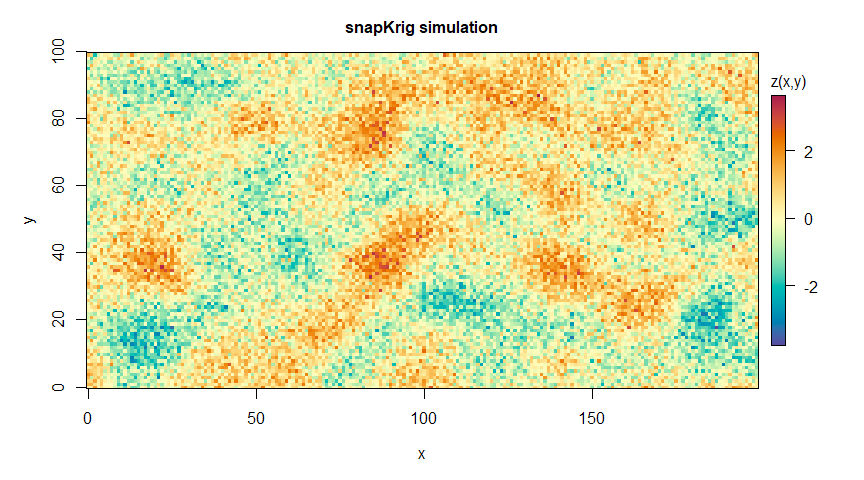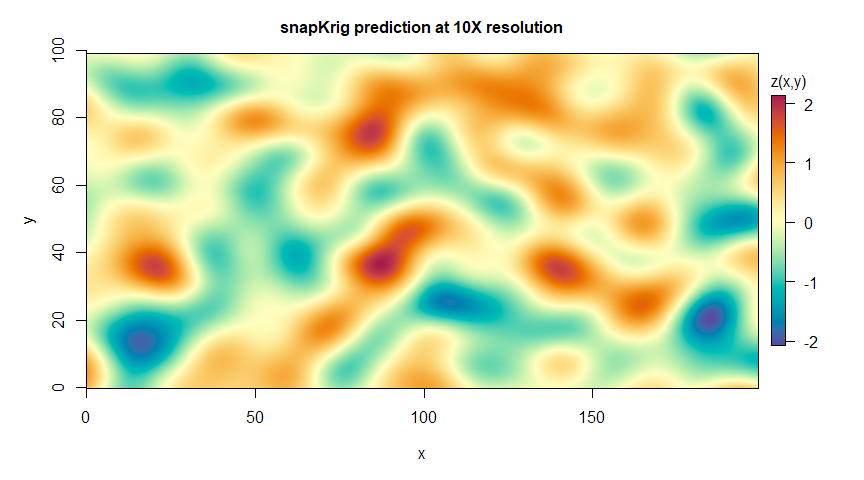
snapKrig is a computationally lean implementation of a 2-dimensional
spatial correlation model for gridded data. By restricting to models
with (separable) Kronecker covariance, the package can speed
computations on certain likelihood and kriging problems by orders of
magnitude compared to alternatives like gstat,
fields, geoR, spatial, and
LatticeKrig.
You can install the development version of snapKrig from GitHub with:
# install.packages("devtools")
devtools::install_github("deankoch/snapKrig")A CRAN release is expected soon.
Define an empty grid to get started
library(snapKrig)
# simulate data on a rectangular grid
g_empty = sk(c(100, 200))
g_empty
#> 100 x 200 emptyGenerate some random auto-correlated data for this grid
# simulate data on a square grid
pars = sk_pars(g_empty)
g_sim = sk_sim(g_empty, pars)
# plot
plot(g_sim, main='snapKrig simulation')
g_sim
#> 100 x 200 completeDownscale and filter noise by simple kriging
# downscale and predict, timing computations
t_start = Sys.time()
g_down = sk_rescale(g_sim, down=10)
g_pred = sk_cmean(g_down, pars, X=0)
#> 100 x 200 complete sub-grid detected
# print time elapsed in computation
t_end = Sys.time()
t_end - t_start
#> Time difference of 0.547658 secs# plot grid
plot(g_pred, main='snapKrig prediction at 10X resolution')
# print summary
summary(g_pred)
#> complete sk grid
#> 1973081 points
#> range [-2.08, 2.13]
#> ..............................
#> dimensions : 991 x 1991
#> resolution : 0.1 x 0.1
#> extent : [0, 99] x [0, 199]snapKrig’s computational efficiency makes it useful in situations where interpolation or down-scaling would pose a problem due to long computation times and/or high memory demands. Such problems are common when working with geo-referenced data in earth sciences. snapKrig’s features include:
snapKrig depends only on packages included by default in
R (like graphics and stats), but supports
raster and geometry classes from sf and
terra.
An earlier incarnation of snapKrig was called pkern. snapKrig is a redesigned version that uses a more user-friendly S3 grid object class.
pkern was an R implementation of some methods I developed in my thesis for speeding up geostatistical computations involving large covariance matrices. The central idea is to model spatial dependence using a separable 2-dimensional covariance kernel, defined as the product of two (1-dimensional) univariate covariance kernels. This introduces special symmetries and structure in the covariance matrix, which are exploited in this package for fast and memory-efficient computations.
I developed snapKrig to support a project to interpolate weather data, but the methods underlying snapKrig are applicable more generally. See also [1], where I use product kernels to study directions of anisotropy in a non-stationary random fields, and [2, 3], where I apply it to fit a covariance structure, and to speed up calculations of dispersal kernel convolutions.